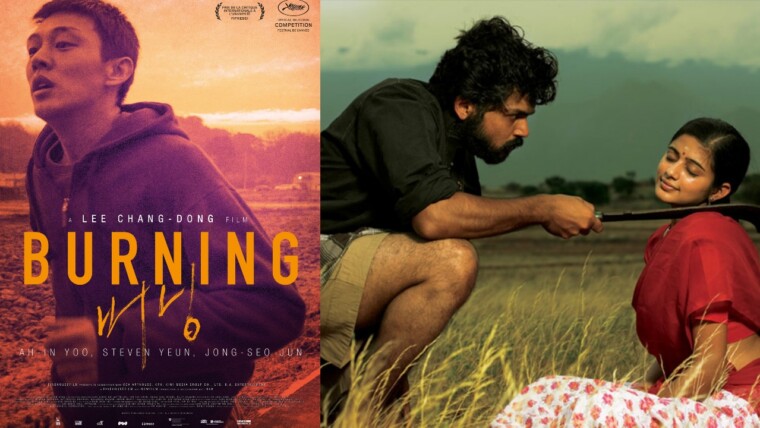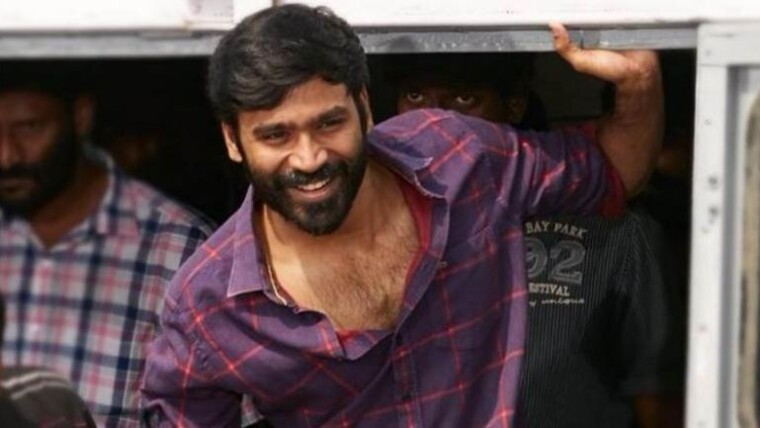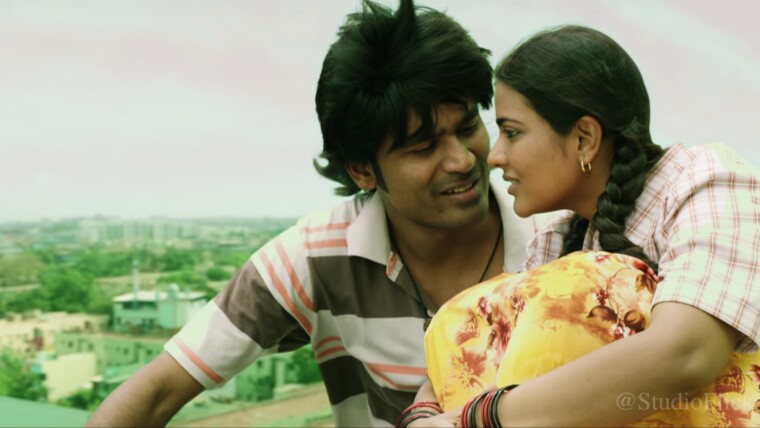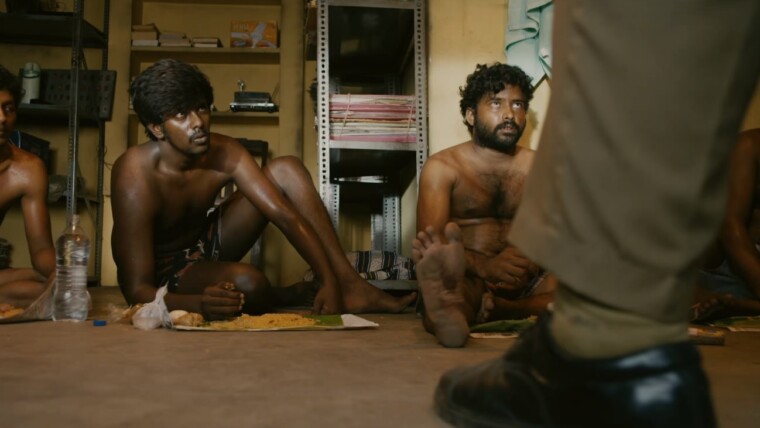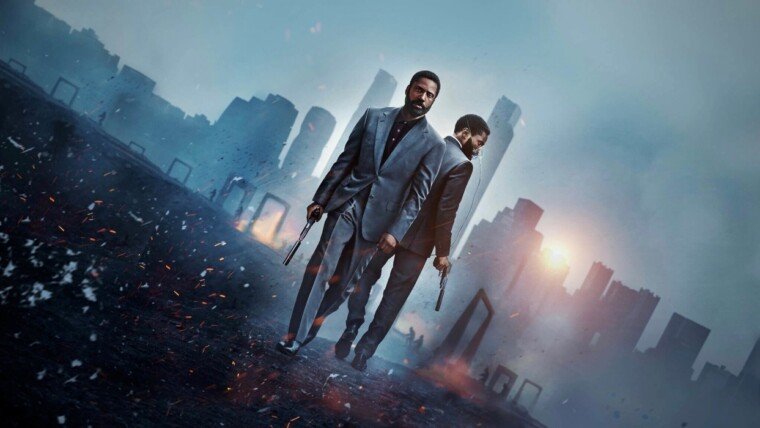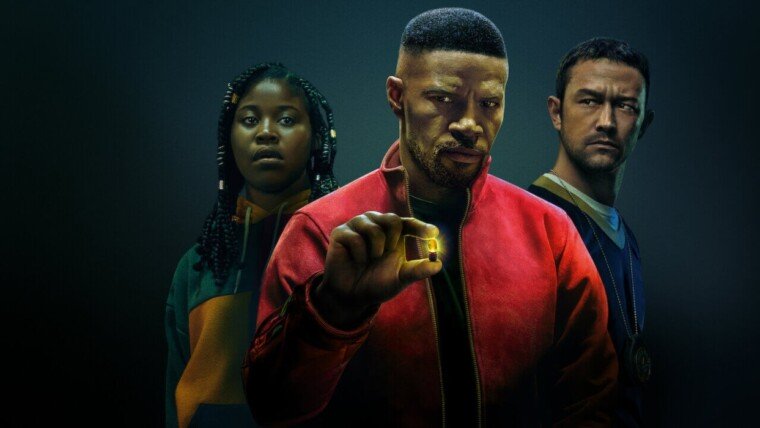This review contains some spoilers…
Note: Slight edits are made to this review after multiple viewings (I bumped up the score as well as commented on the sound mixing).
Vada Chennai (North Chennai) opens with three men drenched in blood sitting at a table in a restaurant as they discuss the repercussions they might face for their very brutal murder of a very powerful man. Immediately we’re hooked, like a redfish swimming by a fishing boat. Questions start forming in our heads. No answers are given… just yet. As the back and forth banter continues, one of them, who’s slightly in the background and marginally out of focus, puts a cigarette in his mouth and strikes a match. It doesn’t light. (You know how sometimes you try lighting a match, and though you strike it multiple times the mafaka just won’t light?) He takes another match out of the box — this time it lights up easily.
Some of you might be wondering why I find that remotely fascinating. But it’s this sorta detailing that makes me salivate. And this Vetri Maaran film is a big fat juicy steak, dripping with detail at every corner of every frame, waiting for you to devour it. I am also and always have been utterly fascinated by worlds like this, with its morally ambiguous characters surrounded by gangsters who wield blood-soaked sickles, corrupt cops, potty-mouthed women (this one I like in real life too), hookers, violence, sex on boats and drug-stuffed rectums. Well, this film doesn’t have hookers, which is a damn shame, but it does have grandmas who say stuff like, “I’ll rip his throat out.”
Early in the film, we find ourselves in a local prison with only a couple of cell blocks, each made into a fortress by a different gang. We see the various activities that take place inside these fortresses. Sometimes these criminals smuggle drugs and electronics in and out of prison by outsmarting the cops, other times they do it with the help of cops. Sometimes we see cops, the good ones, stick their fingers high up the prisoners’ bumholes in search of marijuana. Do these scenes add to the central narrative? Not necessarily. But they do create a sense of atmosphere. In the lived in world of Vada Chennai, the locations are fleshed out, textured characters too.
Here Vetri Maaran has penned a screenplay that is just as smart as it is utterly intoxicating. The film is constructed in such a nonlinear way that you’re constantly on your toes, with a smile on your face as fat as the aforementioned juicy steak. Many a time you think a character is going to react a certain way or be with a particular person because you’ve seen exactly that many scenes ago. But then a flashback kicks in and forces you to question everything you think you know about the story. The film is always one step ahead of you (or at least it was always one step ahead of me).
Very early on, in a flashback sequence, we learn that Chandra (Andrea)’s husband has died. Her godmother prophecises that a young warrior will enter their lives and avenge his death — we see Anbu walking in the background, as the heavenly rays of sunlight fall on him. In many of the scenes that follow, we see Chandra living a happily married life to Guna (Samuthirakani) and so we eagerly anticipate his assassination. But later, in another chapter, there is a reveal, one that sent the cinema into a frenzy. It’s remarkable that none of it is choppy. Here, the nonlinear storytelling rhymes like poetry. Past, present, future and the multitude of characters are woven together seamlessly.

Throughout the film we see characters playing carrom. The sport is important to the community. It’s a form of escapism, no, liberation. It’s a way out — those who excel in sports can land government jobs via the yearly sports quota. This is especially true for our lead character, Anbu. But why carrom specifically? I wondered. Why not football or kabaddi? Perhaps it’s because this tabletop sport reflects both the way Vada Chennai is designed as well as the unfolding lives of the characters in the films.
There are many, many seeds that represent many many characters; two colours (two sides — Senthil’s and Guna’s). The seeds bounce off each other, sending other seeds in various and unpredictable directions. Before the game begins, the seeds are clumped together (a united front) with the red seed, the king (Rajan). But everything goes to shit the moment the seeds are broken (known as the opening break), marking the start of the game.
Consider this. Former Prime Minister of India, Rajiv Gandhi is assassinated, which leads to riots, riots that lead to the meeting of Padma and Anbu. They eventually make out in a public space, causing many of the village men to harass her. This then leads to Anbu killing a man (who happens to be in a gang) prompting members of that gang to hunt him down, which leads to Anbu seeking the opposing gang for protection. All of which runs parallel to the death of another political figure and famous person (MGR) that happens later in the movie (but earlier in the story), which triggers the first series of unfortunate events. That everything makes perfect sense speaks volumes of Vetri Maaran’s stellar writing.

Some of the early reviews have compared this movie to The Godfather. Sure it has similar themes like greed, power and corruption, but it’s not quite the same. It isn’t like Dhanush’s first foray into the gangster genre more than a decade ago, Pudhupettai either. (Though, as far as Tamil cinema goes, it may prove to be just as culturally relevant.) This isn’t a grim, depressing and uncomfortable take on the gangster genre that’ll rip your heart to pieces. In other words, it’s not a Selvaragavhan film. This is a different beast entirely.
It’s a pulpy mess in the best possible ways… speaking off, perhaps the best comparison would be Pulp Fiction. It definitely (intentionally or unintentionally) draws inspiration from many Tarantino films. Consider the way Vada Chennai is divided into chapters — every now and again blocky white words will appear on a black screen like ‘ANBU CHANDRA GUNA’ — that transport us many scenes ago and we observe what different characters are doing during a previously established timeframe. And just like Pulp Fiction, it’s damn near impossible to remember the order of the scenes.

Vetri Maaran is also aggressively in love with the characters he’s birthed. Every single character is interesting, every line of dialogue engrossing. There’s a scene that happens later in the film where characters sit at a table and discuss if they should kill someone. I was thoroughly captivated by their nervous banter, eating up every single word like a starving child. One character goes to the bathroom and then another and another and they continue their discussion there as the target of the hit sits outside, wondering what’s going on — he thinks they’re puking no thanks to one too many drinks. I felt my stomach lurch and my fist tighten.
It’s surprising that Dhanush’s Anbu isn’t the character lead in the movie, that role goes to Ameer’s character Rajan, the key to the whole puzzle. (But Dhanush is the lead. Think of it as something along the lines of Marlon Brando and Al Pacino in The Godfather.) Anbu’s just another seed on the carrom board that gets pushed around. An unwilling hero that frankly wants to stay out of trouble, play the game he’s passionate about, nail himself a government job and marry the woman he loves. Even his name, “Anbu” sounds soft and translates to love/affection, as opposed to say, Maari (the character and movie name of Dhanush’s second foray in the gangster genre). But there’s no denying the old lady’s prophecy and the heavy lights that shined upon him. A transformation is bound to happen. Dhanush’s performance as this character is utterly entrancing. I’ve said it many times, I’ll say it again: the man is one of the best actors working in world cinema today.
The woman he loves is the high spirited Padma, played wonderfully by Aishwarya Rajesh. When Anbu and Padma first bump into each other at a riot, her face is draped like someone from a desert. He wonders aloud if she’s a woman or a man, to which she says, “Yo dumbass! Can’t you tell by sizing up my figure?” I love how her character is outspoken and crass to the bones but pretends to be otherwise when she’s walking around her village, not because she’s pretentious, but because the villagers are judgemental pricks.
As the film progresses, her character, unfortunately, fades into the background, as the seemingly docile homemaker in Chandra makes her way to the forefront and steals the whole damn show. There’s also the sleazy always up to no good Senthil (Kishore), the kind-hearted badass Rajan and many many more. Not only are they well written, they’re also one example after another of inspired casting.

Damn, what a fucking film. Sure, there are nits to be picked. When Anbu changes from tame carrom board player to the fierce avenger we knew he would become, it lacks a certain sense of rhythm. Perhaps there should have been a couple more scenes that lead to his climactic turn at the conference with members of the two gangs and some politicians. As it stands, it feels like there’s a couple of pages missing. (Though, this becomes even lesser of a problem upon multiple viewings).
In a recent interview, Vetri Maaran mentioned how the film’s original cut was more than five hours long and was condensed to two hours and 45 minutes to fit today’s standards. I wish the attention span of contemporary audiences hadn’t held Vada Chennai at ransom at the editing chamber. “Make sure the film is short or you can bet your ass we’ll whip our phones out during the film, scroll through Facebook and share articles that we didn’t read past the clickbaity headline.” I could’ve spent another hour hanging out with these characters.
Vada Chennai is also superbly envisioned by Vetri Maaran and lensed by Velraj, as far as the film’s aesthetics are concerned. At times Vetri Maaran uses a more documentary-esque technique which adds to the realism and makes us feel like we’re a fly on the wall observing the events as they unfold. The action sequence that takes place at night towards the end of the film is dark and purposefully un-stylish. And then there’s the thrilling, perfectly staged and magnificently shot interval fight scene that breaks out in prison under a collapsed tent — it is as inventive and stunning as they come! Santhosh Narayanan’s musical score will give you goosebumps for days, despite the occasionally slightly less than stellar sound mixing.
Billed by the director as his dream project, Vada Chennai was one of my most anticipated films of 2018. And after watching it multiple times, I can confidently say that this truly is an achievement in cinema. A first viewing may not make that clear. There is a lot to absorb, digest and process. But this is a film that gets better and better with multiple viewings, each offering something new. This is an inspired piece of storytelling littered with great actors embodying wonderfully written characters. An absorbing work of art. An absolute masterpiece of a motion picture! Vada Chennai is the reason why I go to the movies.
Hey you! Yes you, hot stuff. Like my article? Leave a comment below and let me know whatchu think. Also, don’t forget to share it with your buds. And if you’d like to discuss the movie with me you can hit me up on Twitter here: @dashtalksmovies


